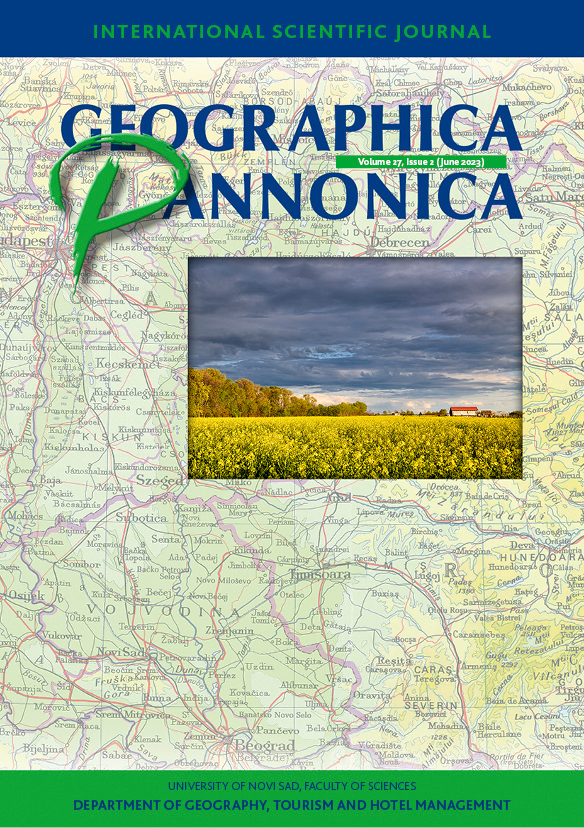Clothing Thermal Resistance in the Human Biometeorological Models
Abstract
Three different clothing thermal resistance (rcl) schemes are compared using meteorological and human data collected in Martonvásár. Model 1 is the most complex, it is energy balance based and it can be used as stand‑alone human biometeorological model. Model 3 is the simplest, it is the UTCI‑clothing model used as sub‑model in the UTCI (Universal Thermal Climate Index) scheme. It uses air temperature as sole input. Model 2 uses more data than model 3, the data used are the thermal insulation values of the clothing worn. Meteorological data refer to the town Martonvásár. The data were collected in the period August 9, 2016 – May 23, 2018. The main result is that the rcl values obtained by model 1 differ significantly in most of the cases from the results obtained by models 3 or 2. The agreement of models 2 and 3 is acceptable. The fact that the results of model 1 rarely match the results of model 3 or model 2 suggests that the energy balance between human body and environment is rarely achieved, merely is this the case in approximately 10 percent of the cases. Further testing is required to be sure of the certainty of the obtained results.
References
Ács, F., Kristóf, E., & Zsákai, A. (2019). New clothing resistance scheme for estimating outdoor environmental thermal load. Geographica Pannonica, 23(4), 245–255. https://doi.org/10.5937/gp23-23717
Auliciems, A., & de Freitas, C. R. (1976). Cold stress in Canada. A human climatic classification. International Journal of Biometeorology, 20(4), 287–294. https://doi.org/10.1007/BF01553585
Auliciems, A., & Kalma, J. D. (1979). A Climatic Classification of Human Thermal Stress in Australia. Journal of Applied Meteorology (1962-1982), 18(5), 616–626.
Błażejczyk, K., Broede, P., Fiala, D., Havenith, G., Holmér, I., Jendritzky, G., Kampmann, B., & Kunert, A. (2010). Principles of the New Universal Thermal Climate Index (UTCI) and its Application to Bioclimatic Research in European Scale. Miscellanea Geographica, 14(1), 91.
Błażejczyk, K., Jendritzky, G., Bröde, P., Fiala, D., Havenith, G., Epstein, Y., Psikuta, A., & Kampmann, B. (2013). An introduction to the Universal Thermal Climate Index (UTCI). Geographia Polonica, 86(1), 5.
de Freitas, C. R., & Grigorieva, E. A. (2015). A comprehensive catalogue and classification of human thermal climate indices. International Journal of Biometeorology, 59(1), 109–120. https://doi.org/10.1007/s00484-014-0819-3
Fanger, P. O. (1970). Thermal comfort. Analysis and applications in environmental engineering. Thermal comfort. Analysis and applications in environmental engineering. https://www.cabdirect.org/cabdirect/abstract/19722700268
Fanger, P. O. (1973). Assessment of man’s thermal comfort in practice. British Journal of Industrial Medicine, 30(4), 313–324. https://doi.org/10.1136/oem.30.4.313
Fiala, D., Havenith, G., Bröde, P., Kampmann, B., & Jendritzky, G. (2012). UTCI-Fiala multi-node model of human heat transfer and temperature regulation. International Journal of Biometeorology, 56(3), 429–441. https://doi.org/10.1007/s00484-011-0424-7
Gagge, A. P., Burton, A. C., & Bazett, H. C. (1941). A Practical System of Units for the Description of the Heat Exchange of Man with His Environment. Science, 94(2445), 428–430. https://doi.org/10.1126/science.94.2445.428
Havenith, G., Fiala, D., Błazejczyk, K., Richards, M., Bröde, P., Holmér, I., Rintamaki, H., Benshabat, Y., & Jendritzky, G. (2012). The UTCI-clothing model. International Journal of Biometeorology, 56(3), 461–470. https://doi.org/10.1007/s00484-011-0451-4
Höppe, P. (1999). The physiological equivalent temperature – a universal index for the biometeorological assessment of the thermal environment. International Journal of Biometeorology, 43(2), 71–75. https://doi.org/10.1007/s004840050118
Innova Air Tech Instruments (2002). Thermal Comfort. Innova Air Tech Instruments, 32 pp. (it is available from the authors on the request).
Olesen, B. W. (1985). A new simpler method for estimating the thermal insulation of a clothing ensemble. ASHRAE Transactions, 91(2B), 478–492.
Parsons, K. (2014). Human Thermal Environments: The Effects of Hot, Moderate, and Cold Environments on Human Health, Comfort, and Performance, Third Edition (3rd ed.). CRC Press. https://doi.org/10.1201/b16750
Potchter, O., Cohen, P., Lin, T.-P., & Matzarakis, A. (2018). Outdoor human thermal perception in various climates: A comprehensive review of approaches, methods and quantification. Science of The Total Environment, 631–632, 390–406. https://doi.org/10.1016/j.scitotenv.2018.02.276
Weyand, P. G., Smith, B. R., Puyau, M. R., & Butte, N. F. (2010). The mass-specific energy cost of human walking is set by stature. The Journal of Experimental Biology, 213(Pt 23), 3972–3979. https://doi.org/10.1242/jeb.048199
Yan, Y. Y. (2005). Climate Comfort Indices. In J. E. Oliver (Ed.), Encyclopedia of World Climatology (pp. 227–231). Springer Netherlands. https://doi.org/10.1007/1-4020-3266-8_44
Yan, Y. Y., & Oliver, J. E. (1996). The Clo: A Utilitarian Unit to Measure Weather/Climate Comfort. International Journal of Climatology, 16(9), 1045–1056. https://doi.org/10.1002/(SICI)1097-0088(199609)16:9<1045::AID-JOC73>3.0.CO;2-O

